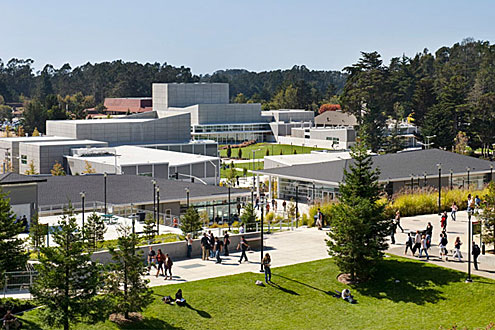By Jondi Gumz
In 1959, Wally Trabing, a columnist for the Santa Cruz Sentinel, suggested naming the new community college after explorer Juan Rodriguez Cabrillo, the first European to arrive at the California coast in 1542.
 The college had been placed in Aptos, the midpoint between rival communities in Santa Cruz and Watsonville, and the Cabrillo name was acceptable — until now.
The college had been placed in Aptos, the midpoint between rival communities in Santa Cruz and Watsonville, and the Cabrillo name was acceptable — until now.
Faculty members led by John Govsky, a digital media instructor, petitioned trustees for a change, citing Juan Cabrillo’s violent history. Madison Raasch, who served as student trustee last year, agreed.
Others questioned whether spending $1 million on a name change — the cost estimate from Cabrillo superintendent/president Matt Wetstein — was the best choice to support students and the trustees’ goal to prioritize equity, ensuring every student has an equal opportunity for success.
If you haven’t explored Cabrillo’s history, here’s a report from historian Gary Kamiya, who shared this story from biographer Harry Kelsey in the San Francisco Chronicle: At 13, Cabrillo was a young soldier who was first to draw his sword against Taino Indians in Cuba, resulting in a slaughter of nearly all the natives in the village.
The reassessment of Cabrillo’s name comes in the wake of universities elsewhere reassessing their history, acknowledging stains and in some cases, making amends.
- Harvard University
Harvard figures Cotton Mather, the Puritan minister, and John Hancock, who signed the Declaration of Independence, owned slaves.
Buried with expensive headstones near campus are Cicely and Jane, slave servants who served prominent Harvard men.
In 2016, Harvard Law School retired its logo because it was based on the family crest of an 18th century slave-holding family of Isaac Royall Jr., who endowed the first law professorship at Harvard in 1815. His father owned a Caribbean plantation and built the family fortune trading in sugar, rum and slaves.
Harvard now offers a course called “Harvard and Slavery” but some students say the university should do more.
- Georgetown University
Georgetown was kept afloat in tough financial times in 1838 when Jesuits who ran the college sold 272 men, women, and children to pay college debts.
In 2019, Georgetown students voted to establish a student fee to fund reparations for descendants of the 272 slaves.
Georgetown renamed buildings bearing the names of Jesuits Thomas Mulledy and William McSherry, who had played key roles in the sale. The buildings are now named for Isaac Hawkins, the first slave sold in 1838, and Anne Marie Becraft, a free woman of color who established a school in Georgetown for black girls.
- University of Virginia
The University of Virginia was built by slaves; students and faculty were served by slaves.
In 2013, the university established a commission to examine its slavery connections. Since then, the university has acknowledged its participation in slavery and honored the people once enslaved.
Students helped create a slavery walking tour of campus, and a prominent stone memorial is to honor an estimated 5,000 slaves working there between 1817 and 1865, when slaves were freed by President Lincoln.
Reckoning With History
In athletics, business and even environmental activism, organizations are reckoning with racism in their history in the era of George Floyd, who was killed in May in Minneapolis while in police custody, and the Black Lives Matter movement.
 The reporters who cover Major League Baseball will consider whether to rename the J.G. Taylor Spink Award, because it recognizes the Sporting News publisher who helped delay integration of baseball.
The reporters who cover Major League Baseball will consider whether to rename the J.G. Taylor Spink Award, because it recognizes the Sporting News publisher who helped delay integration of baseball.
They are also considering whether to wipe the name of longtime baseball commissioner Kennesaw Mountain Landis from the Most Valuable Player trophy, because during his tenure from 1920-1944, the sport was basically all white.
Two professional football teams are dropping names considered to be ethnic slurs: the Redskins in the NFL will become the Washington Football Team while searching for a new permanent name; and the Edmonton team in the Canadan Football League will no longer be called the Eskimos.
Trader Joe’s grocery chain is phasing out Trader Ming and Trader Jose packaging after Briones Bedell, a high school student in Oakley, started a petition on Change.org, saying the marketing played on racial stereotypes.
This past week, the head of Sierra Club apologized for founder John Muir making derogatory comments about Black and indigenous people and for his friendship with paleontologist Henry Fairfield Osborn, president of the American Museum of National History, who contended the Nordic race was superior.
Committee Created
During the annual retreat on July 20, Cabrillo College trustees voted 7-1 to create a board subcommittee, likely with three trustees, to seek input from stakeholders, internal and external, on a name change.
Adam Spickler was the sole nay vote. He favored a different process but he volunteered for the subcommittee, saying he’s not up for re-election.
Voting yes were: Edward Banks, Donna Ziel, Dan Rothwell, who are not up for election, and student trustee Amidia Frederick.
Also voting yes: Christina Cuevas, Rachael Spencer and Leticia Mendoza, who are up for re-election. Cuevas and Spencer have already filed papers saying they plan to run again.
Trustee Comments
Here are some of the comments trustees made on the name issue:
- Edward Banks (who consulted historian Sandy Lydon to find out how the name was chosen): “I don’t discount anything that anybody said. I still feel very conflicted over any name change.”
- Adam Spickler: “In the end, this will be a political decision.”
- Donna Ziel: “From what I heard tonight, it’s really important to have the student voice heard.”
- Christina Cuevas: “Our highest goal is equity for students. What’s the best we can do where we make students feel welcome and they can succeed?”
- Rachael Spencer: “The timing is really difficult. The communication is difficult … It’s going to take a lot of work to bring the community to understand this.”
- Amidia Frederick, (student trustee): “Sensitivity is going to keep growing. As an institution that cares about equity, we do need to go forward with the option to investigate this. We’re not fast-tracking this.”
- Dan Rothwell: “We want to be very open about receiving information. This is a hotbed, a political decision that can incite pretty strong feelings.”
The Process
The Cabrillo College Governing Board next meets at 6 p.m. Aug. 3 on Zoom. The subcommittee will likely be created then. Interested board members have been invited to notify Board Chair Leticia Mendoza of their willingness to serve. The agenda will be posted at go.boarddocs.com/ca/cabrillo/Board.nsf/Public
The review will likely take months.
The Board subcommittee approach will allow select Board members to steer the process of studying the college name, its historic roots, and whether a more appropriate name is in order. External constituents from the business, education, and Cabrillo alumni community will be invited to provide input.
The subcommittee will develop recommendations that will go to the full Governing Board for a vote.
Renaming involves expenses such as changing signs on the campus and on highways and roadways, changing way-finding maps, and obtaining a new website domain name, marketing materials and legal costs required for a name change.



